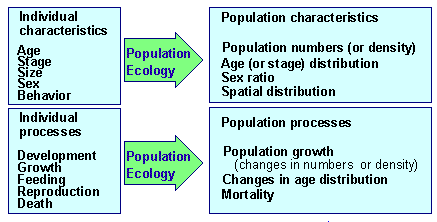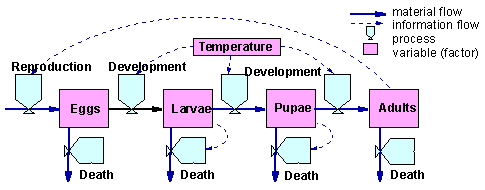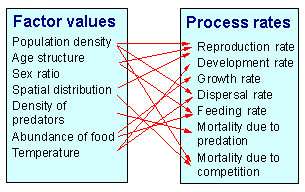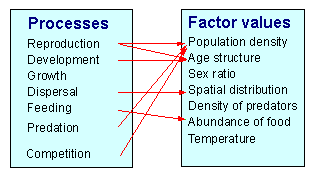 | What is Population Ecology? |
Population ecology relative to other ecological disciplines |
The major problem in population ecology is to derive population characteristics from characteristics of individuals and to derive population processes from the processes in individual organisms: |
|
The model of Forrester is based on tank-pipe analogy. The system is considered as a set of tanks connected by pipes with vents which can regulate the "flow" of liquid from one tank to another. The flow of "liquid" between tanks is considered as "material flow". However there is also "information flow" that regulates the vents. Vents are equivalent to processes; and the amount of liquid in a tank is a variable or a factor because it can affect processes via information flow.The figure above is the Forrester diagram for an insect population system with 4 stages: eggs, larvae, pupae, and adults. Transition between these states (development) is regulated by temperature. Influx of eggs depends on the number of adults. Mortality occurs in all stages of development. Larval and pupal mortality is density-dependent. |
Interaction of factors and processes. Factors affect the rate of processes |
On the other hand, processes change the values of factors. Life tables show various mortality processes in the population but they do not indicate the role of factors. To analyze the role of factors, it is necessary to vary these factors experimentally and examine how they affect various mortality processes. These experiments may show, for example, that the rate of parasitism depends on the density of parasites, density of hosts, and temperature. To understand population dynamics, it is necessary to know both the effect of factors on the rate of various processes, and the effect of processes on various ecological factors (e.g., on population density). This information is integrated via modeling. |
Population Systems and Their Components
Ģ Population ecology is the branch of ecology that studies the structure and dynamics of populations.
Ģ Physiology studies individual characteristics and individual processes. These are use as a basis for prediction of processes at the population level.
Ģ Community ecology studies the structure and dynamics of animal and plant communities. Population ecology provides modeling tools that can be used for predicting community structure and dynamics.
Ģ Population genetics studies gene frequencies and microevolution in populations. Selective advantages depend on the success of organisms in their survival, reproduction and competition. And these processes are studied in population ecology. Population ecology and population genetics are often considered together and called "population biology". Evolutionary ecology is one of the major topics in population biology.
Ģ Systems ecology is a relatively new ecological discipline which studies interaction of human population with environment. One of the major concepts are optimization of ecosystem exploitation and sustainable ecosystem management.
Ģ Landscape ecology is also a relatively new area in ecology. It studies regional large-scale ecosystems with the aid of computer-based geographic information systems. Population dynamics can be studied at the landscape level, and this is the link between landscape- and population ecology.
The term "population" is interpreted differently in various sciences:
Ģ In human demography a population is a set of humans in a given area.
Ģ In genetics a population is a group of interbreeding individuals of the same species, which is isolated from other groups.
Ģ In population ecology a population is a group of individuals of the same species inhabiting the same area.
Interbreeding is seldom considered in ecological studies of populations. The exceptions are studies in population genetics and evolutionary ecology.
Populations can be defined at various spatial scales. Local populations can occupy very small habitat patches like a puddle. A set of local populations connected by dispersing individuals is called a metapopulation. Populations can be considered at a scale of regions, islands, continents or seas. Even the entire species can be viewed as a population.
Populations differ in their stability. Some of them are stable for thousands of years. Other populations persist only because of continuous immigration from other areas. On small islands, populations often get extinct, but then these islands can be re-colonized. Finally, there are temporary populations that consist of organisms at a particular stage intheir life cycle. For example, larvae of dragonflies live in the water and form a hemipopulation (term of Beklemishev).
Main axiom of population ecology: organisms in a population are ecologically equivalent. Ecological equivalency means:
1. Organisms undergo the same life-cycle
2. Organisms in a particular stage of the life-cycle are involved in the same set of ecological processes
3. The rates of these processes (or the probabilities of ecological events) are basically the same if organisms are put into the same environment (however some individual variation may be allowed).
1.2. Models as analytical tools
Population ecology is the most formalized area in biology.
Model is a tool and should never be considered an ultimate goal in ecological studies.
Model and reality are linked together by two procedures: abstraction and interpretation:
Abstraction means generalization: taking the most important components of real systems and ignoring less important components. Importance is evaluated by the relative effect of system components on its dynamics. For example, if we found that parasitism rate in insect pest is always below 5%, then parasitoids can be excluded from the model.
Interpretation means that model components (parameters, variables) and model behavior can be related to components, characteristics, and behavior of real systems. If model parameters have no interpretation, then they cannot be measured in real systems.
Most field ecologists are not good at abstraction. If they build a model they often try to incorporate every detail. Most mathematicians are not good at interpretation of their models. Usually they think of clean models and dirty reality. However, both abstraction and interpretation are necessary for successful modeling. Thus, close collaboration between ecologists and mathematicians is very important.
Models are always wrong ... but many of them are useful.
How it may happen that the wrong model can give a correct answer? In the same way as old maps, which assumed a flat earth and used wrong distance relations, where useful for travelers in the past.
Modeling strategy:
1. Select optimal level of complexity
2. Never plan model development for more than 1 year
3. Avoid the temptation to incorporate all available information into the model
4. Follow specific objectives, don''t try to make a universal model
5. If possible, incorporate already existing models
System properties and model properties
1. Many system properties are not represented in the model.
Example: age structure is not represented in both exponential and logistic models.
2. Some model properties cannot be found in real systems.
Example: solutions of differential equations are always smooth, while trajectories of real systems are always noisy.
Example of a wrong question: Does this population have an equilibrium density?
The stable equilibrium is a state to which all trajectories of the system converge infinitely close with increasing time. The model (e.g. the differential equation) may have an equilibrium density, but real populations don''t have it because:
1. Population density cannot be measured with infinite accuracy.
2. Weather fluctuations always add noise to system''s dynamics.
3. Time series are never long enough to talk about limits and convergence.
1.3. Population system
Population system (or a life-system) is a population with its effective environment.
The term "life-system" was introduced by Clark et al. (1967). Later, Berryman (1981) suggested another term "population system" which is definitely better. A short review of the life-system methodology was published by Sharov (1991).
Major components of a population system
1. Population itself. Organisms in the population can be subdivided into groups according to their age, stage, sex, and other characteristics.
2. Resources: food, shelters, nesting places, space, etc.
3. Enemies: predators, parasites, pathogens, etc.
4. Environment: air (water, soil) temperature, composition; variability of these characteristics in time and space.
Temporal and spatial structure of a population system
Temporal structure
Diurnal cycles
Seasonal cycles
Long-term cycles Spatial structure
Spatial distribution
Habitat structure
Metapopulations
Dynamics of Population Systems
Factor-Effect concept: Environmental factors affect population density. When factors change then population density changes respectively.
Advantage: Causal explanation of population change
Disadvantage: It is useful for one-step instant effects but becomes confusing if the effect is simultaneously a factor that causes soemthing else, or if there are time delays in the effect.
Factor-Process concept: Environmental factors do not affect population density directly, instead they affect the rate of various ecological processes (mortality, reproduction, etc.) which finally result in a change of population density. Processes can change the value of factors; thus, feedback loops become possible.
Advantage: Can handle complex dynamic interactions among components of population systems including time-delays, negative and positive feedbacks.
In 50-s and 60-s there was a discussion about population regulation between two schools in population ecology. An agreement could not be reached because these schools used different concepts of population dynamics. Andrewartha and Birch (1954) used the factor-effect concepts whereas Nicholson (1957) used the factor-process concept.
The factor-process concept works not only in population ecology but in any kind of dynamic systems, e.g. in economic systems. Forrester (1961) formalized the factor-process concept and applied it to industrial dynamics. Later this formalism became very popular in ecology and is widely used especially in ecosystem modeling.
The model of Forrester is based on tank-pipe analogy. Diagrams of Forrester can be easily transformed into differential equation models. Each process becomes a term in a differential equation that determines the dynamics of the variable. For example, the number of larvae in the figure above is affected by 3 processes: egg development ED(T), larval development LD(T), and larval mortality LM(N). Egg and larval development rates are functions of temperature T; whereas larval mortality is a function of larval numbers N. The equation for larval dynamics is the following:
dN/dt = ED(T) - LD(T) - LM(N)
Here the term ED(T) is positive because egg development increases the number of larvae ("liquid" influx). Terms LD(T) and LM(N) are negative because larval development (molting into pupae) and mortality reduce the numbers of larvae.
Limitations of Forrester''s model:
1. Distinction between information and material flows was not clear because information cannot be transferred without any matter. For example: egg or seed production is not only an information flow, there is a flow of matter too.
2. Only one type of processes is considered in which "fluid" moves from one tank to another. This is good representation of organisms changing their state. However, it is impossible to apply the model to the processes that involve two or more participants. For example, when a parasite enters a host then it is impossible to make a "pipe" that starts from two "tanks": host and parasite, and ends in the "tank" of "parasitized host".
3. Only one level of processes is considered. In some cases it is important to consider processes at two spatial levels, e.g., the dynamics of phytophagous insects can be considered within a host plant and within a population of host plants.
Other models has been developed to represent the factor-process concept. Petri nets consider interactions of one two, or more participants. However, there is no generic model with no limitations.
Factors and processes
The dynamics of a system is always viewed as a sequence of states. State is an abstraction like an arrow hanging in the air but it helps to understand the dynamics. Because systems are built from components, the state can be represented as a combination of states of all its components. For example, the state of the predator-prey system can be characterized by the density of prey (component #1) and density of predators (component #2). As a result, the state of the system can be considered as a point in a 2-dimensional space with coordinates that correspond to system components. This space is usually called the phase space
Components of the system will be called factors because they affect system dynamics. The state of the component is the value of the factor. Factors are considered with as many details as necessary for understanding system''s dynamics.
Examples of factors:
Ģ In simple models (e.g., exponential or logistic), there is only one factor (=component): the population itself. Its value is population density.
Ģ In age-structured populations, each age class is a factor and its value is equal to the density of individuals in that class.
Ģ Natural enemies and various resources can be considered as additional factors. Then, the abundance of predators, parasites, or food will be values of these factors.
Ģ Weather can be viewed as a set of factors: temperature, precipitation, etc. Each of these factors has a numerical value.
Ģ Factors may have a hierarchical structure. If the population occupies multiple patches in space, then all factors (e.g., population density, density of natural enemies and resources, temperature) become patch-specific.
Any detectable change in the population system is considered as an event. Events can be classified according to the components involved in these events. The process can be defined as a class of identical events. The rate of a process can be measured by the number of events that occur in the system per unit time. Also, the specific rate of processes is often used which is the number of events per time unit per one organism involved in the event.
Examples of processes
Ģ The birth of an organism is an event. The birth rate is the number of births per unit time. The specific birth rate (= reproduction rate) is the birth rate per 1 female (or per 1 parent).
Ģ Death of an organism is an event. Mortality on a specific stage from a specific cause (e.g., parasitism, predation, starvation) is a process. Mortality rate is the number of deaths per unit time. Specific mortality rate is the number of deaths per unit time per organism.
Ģ Other processes are: growth, development, consumption of resources, dispersal, entering diapause, etc.
Interaction of factors and processes
A process may be affected by multiple factors. For example, mortality caused by predation may depend on the prey density, predator density, number of refuges, temperature (if it changes the activity of organisms), etc.
The value of a factor may change due to multiple processes. For example, the number of organisms on a specific stage changes due to development (entering and exiting this stage), dispersal, and mortality due to predation, parasitism, and infection.
Thus, there is no one-to-one correspondence between factors and processes. Life-tables show the rate of various mortality processes, but they do not show the effect of factors on these processes. For example, parasitism may be mostly determined by weather; viral infection may be determined by host plant chemistry. But life-tables do not show the effect of either weather or and host plant chemistry.
It is dangerous to judge on the role of factors (e.g., biotic vs. abiotic) from life-tables. For example, a life-table may show that 90% mortality of an insect is caused by parasitism. This may lead to an erroneous conclusion that parasites rather than weather are most important in the change of population density. It may appear that the synchrony between life cycles of the host and parasite depends primarily on weather.
Life tables show various mortality processes in the population but they do not indicate the role of factors. To analyze the role of factors, it is necessary to vary these factors experimentally and examine how they affect various mortality processes.
Next (part1)
Next (part2)
Next (part3)
A life-system:Sharov, A. A. 1992. Life-system approach: a system paradigm in population ecology.





